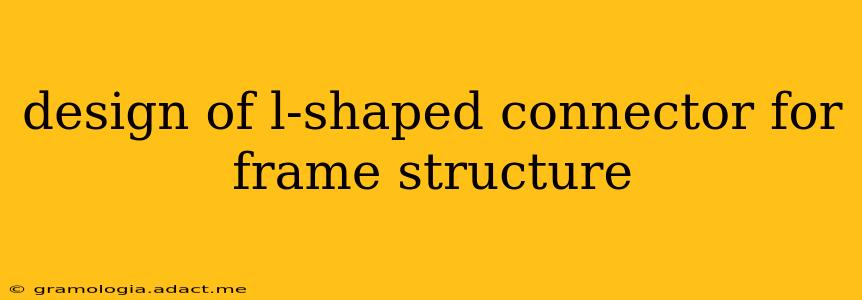L-shaped connectors play a crucial role in the construction of frame structures, providing robust and efficient connections between different structural members. Their design requires careful consideration of several factors to ensure structural integrity, load-bearing capacity, and ease of assembly. This comprehensive guide delves into the key aspects of designing effective L-shaped connectors for frame structures.
What are the Different Types of L-Shaped Connectors?
L-shaped connectors come in a variety of materials and configurations, each suited for specific applications and load requirements. Common types include:
-
Welded L-Shaped Connectors: These are typically fabricated from steel plates and are welded to the connecting members. They offer high strength and rigidity but require specialized welding equipment and skilled labor.
-
Bolted L-Shaped Connectors: These utilize bolts to connect the L-shaped plate to the structural members. They are easier to install than welded connectors and allow for easier disassembly if needed. Different bolt types and configurations (e.g., high-strength bolts) can be used to optimize strength and stiffness.
-
Cast L-Shaped Connectors: These connectors are cast from materials like ductile iron or aluminum alloys. They provide a good balance between strength and weight and can be designed with intricate geometries.
-
Forged L-Shaped Connectors: Forging creates a high-strength connector with excellent fatigue resistance. These connectors are particularly suitable for high-stress applications.
The choice of connector type depends on factors such as the material of the frame members, the applied loads, the required stiffness, the ease of installation, and cost considerations.
What are the Key Design Considerations for L-Shaped Connectors?
Designing an effective L-shaped connector requires considering several crucial factors:
Material Selection:
The material's yield strength, tensile strength, and fatigue resistance are vital. Steel is the most common choice due to its high strength-to-weight ratio. Aluminum alloys may be considered for applications requiring lighter weight, but their lower strength should be accounted for.
Geometry and Dimensions:
The dimensions of the L-shaped plate (leg lengths, thickness) are critical. These dimensions directly influence the connector's strength, stiffness, and resistance to buckling. Finite element analysis (FEA) is often used to optimize the geometry for maximum load-bearing capacity.
Connection Details:
The method of connecting the L-shaped plate to the structural members significantly impacts performance. Welded connections offer high strength but require precise welding techniques. Bolted connections offer flexibility but require careful bolt selection and tightening procedures to avoid over-tightening or loosening.
Load Transfer Mechanism:
Understanding how the load is transferred through the connector is essential. The design should ensure efficient load transfer from the connected members to the L-shaped plate and minimize stress concentrations.
Fatigue Considerations:
If the connector is subjected to cyclic loading, fatigue resistance becomes a critical design factor. The design should account for potential fatigue failure mechanisms and incorporate appropriate safety factors.
How Do I Determine the Required Strength of an L-Shaped Connector?
Determining the required strength involves a thorough structural analysis. This typically involves:
- Load Calculation: Calculate the loads acting on the connector, including dead loads, live loads, and wind loads.
- Stress Analysis: Use appropriate analysis methods (e.g., finite element analysis) to determine the stresses in the connector under the calculated loads.
- Strength Verification: Verify that the stresses are within the allowable limits of the chosen material, considering safety factors.
Professional structural engineers use sophisticated software and design codes to accurately determine the required strength and ensure the connector meets relevant building codes.
What are Common Failure Modes of L-Shaped Connectors?
Understanding potential failure modes is crucial for safe and reliable design. Common failure modes include:
- Fracture: The connector may fracture due to excessive stress exceeding the material's tensile strength.
- Buckling: The legs of the L-shaped plate may buckle under compressive loads.
- Shear Failure: The connector may fail in shear at the connection points.
- Fatigue Failure: Cyclic loading can lead to fatigue cracks and eventual failure.
How do I Select the Right Fasteners for L-Shaped Connectors?
The selection of fasteners (bolts, welds) depends on the load requirements, the material of the frame members, and the desired level of reliability. High-strength bolts are often preferred for bolted connections, while welds should be performed by qualified welders according to appropriate welding codes.
Conclusion
The design of L-shaped connectors for frame structures requires careful consideration of various factors to ensure structural integrity, load-bearing capacity, and ease of assembly. Proper material selection, geometry optimization, connection detailing, load transfer mechanisms, and fatigue considerations are all crucial for creating a robust and reliable design. Consulting with a structural engineer is highly recommended for complex projects or high-load applications.
